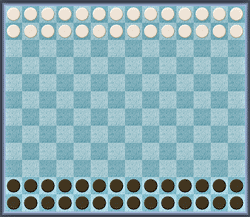|
 |
Origin
Epaminondas was invented by Robert Abbott and published by him privately in 1975.
The name comes from the Theban general who invented the phalanx, a formation he used to defeat the Spartans in 371 B.C. The term phalanx is used in the game to describe a certain arrangement of pieces that can move and capture as a single unit.
Robert Abbott has also invented some other interesting games that you can find in his own page Logic Mazes
Description
Epaminondas is played on a 14 x 12 board with 28 black pieces and 28 white pieces. The board is set up in the starting position shown, with each player pieces placed on the first two back rows.

Objective
Players must move their pieces up the board to occupy opponent´s back rank.
How the game goes on
Black and white take turns to move. White moves first. Theese are the possible kind of moves:
- A single piece may be moved one space in any direction, as a king in chess
- Move a phalanx: a phalanx is defined as a connected group of two or more pieces in a straight line, either orthogonally or diagonally. A piece may belong to several phalanxes in different directions.
When a phalanx moves, all the pieces in the phalanx move an equal number of squares in the same direction in a straight line. The direction of movement must be either forward or backward along the line of orientation of the phalanx.
A phalanx can be split up to move.
The number of squares moved by each piece must be equal to or less than the total number of pieces in the moving phalanx. - Capture: the leading piece of a moving phalanx can move onto a square occupied by an enemy piece. The phalanx´s movement must then stop. In order to move onto this square occupied by an enemy piece, the number of pieces in the phalanx to which this enemy piece belongs, extending back in the direction of movement of the moving phalanx, must be strictly less than the number of pieces in the moving phalanx.
In this case, the enemy piece is captured together with all pieces in the phalanx to which it belongs, extending back in the direction of movement of the moving phalanx. Captured pieces are removed from the board and take no further part in the game.
End of the game
The winner is the player who, at the start of the own turn, have more pieces on the opponent´s back rank than the opponent has on the own back rank.
When one of the players has, after doing a move, more pieces in the last rank than the opponent, this is somehow in check. So, these are the kind of moves that use to check the opponent or prevent his victory:
- Put one of the own pieces onto the own last row.
- Capture some piece in the last opponent´s row.
There is one final complication: black could maintain a position of perfect symmetry and thereby force a draw.
In order to overcome this an additional rule is necessary: a player may not move a piece onto the row furthest from him if that move would create a pattern of left-to-right symmetry.
Play now
Play online with some other players
Related links
Copyright © 2001-2026 Ludoteka.com Jokosare S.L. All rights reserved - Disclaimer - Cookies - Contact
